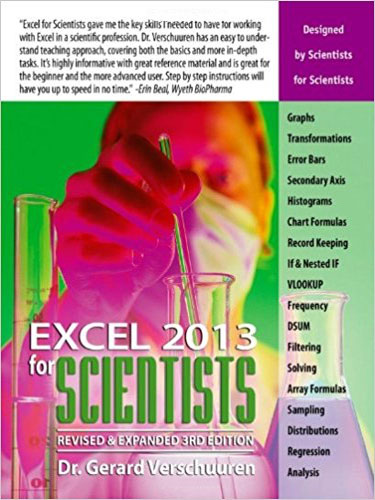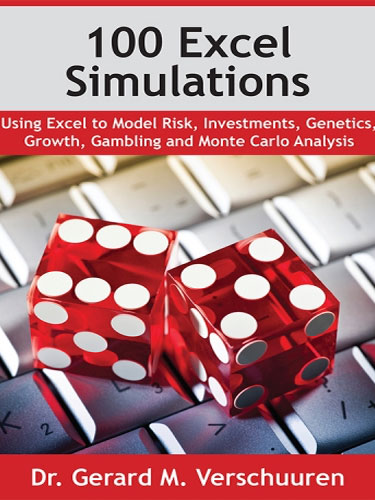Excel 2013 for Scientists
March 2014

Excel 2013 offers significant new features over previous versions of Excel
From Automatic Formula Replication to Formula Autocomplete, these features can have you working faster than you thought possible! Dr. Gerry Verschuuren responds with a third edition covering all of the new features, plus expanded content throughout the book - a book which may also be used in conjunction with Dr. Verschuuren's other science offering: Excel 2013 For Scientists: Complete Excel 2013 Course for the Sciences on CD.
Add to Cart: $9.99 »- 250 Pages
- Publisher: Holy Macro! Books
- ISBN: 978-1-61547-025-9
- PDF ISBN: 978-1-61547-217-8
Training for Excel 2013 - written for scientists by a scientist!
You're a Scientist! Aren't you tired of trying to learn Excel from an accountant's perspective? This book will cover the topics truly important to science as well as engineering professionals. Learn about sampling distributions and regressions and graphing. With examples from the world of science and engineering, this reference teaches scientists how to create graphs, analyze statistics and regressions, and plot and organize scientific data. Physicists and engineers can learn the tips and techniques of Excel—and tailor them specifically to their experiments, designs, and research.
With Excel 2013 for Scientists, you will learn when to use NORMDIST vs NORMSDist and CONFIDENCE vs Z; how to keep data-validation lists on a hidden worksheet; how to use use Pivot Tables to Chart frequency distribution, generate random samples with various characteristics, and much more. Ideal for students and professionals alike, this handbook will enable greater productivity and efficiency. Excel 2013 for Scientists quickly guides the reader through topics such as sampling, estimating, distributions, testing, graphing, and data analysis. Being a scientist, Dr. Verschuuren hits upon the important topics that all accounting-centric books ignore - take a look:
Note
This BOOK, "Excel 2013 for Scientists", by Dr. Gerard Verschuuren, may be used in conjunction with the Excel 2013 for Scientists CD or as a stand-alone product.
- About the Author v
-
Part 1: General Spreadsheet Techniques 1
- Chapter 2: The Fill Handle 5
- Chapter 3: Relative vs. Absolute Cell References 7
- Chapter 4: Range Names 10
- Chapter 5: Nested Functions 15
- Part 1 Exercises 18
-
Part 2: Data Analysis 25
- Chapter 7: Subtotals 28
- Chapter 8: Summary Functions 33
- Chapter 9: Unique Lists 35
- Chapter 10: Data Validation 37
- Chapter 11: Conditional Formatting 41
- Chapter 12: Filtering Tools 45
- Chapter 13: Lookups 47
- Chapter 14: Working with Trends 54
- Chapter 15: Fixing Numbers 56
- Chapter 16: Copying Formulas 62
- Chapter 17: Multi-cell Arrays 64
- Chapter 18: Single-cell Arrays 69
- Chapter 19: Date Manipulation 75
- Chapter 20: Time Manipulation 79
-
Part 2 Exercises 82
-
Part 3: Plotting Data 97
- Chapter 22: A Chart’s or Graph’s Data Source 104
- Chapter 23: Combining Chart Types 108
- Chapter 24: Changing Graph Locations 112
- Chapter 25: Templates and Defaults 116
- Chapter 26: Axis Scales 118
- Chapter 27: More Axes 122
- Chapter 28: Error Bars 126
- Chapter 29: More Bars 129
- Chapter 30: Line Markers 132
- Chapter 31: Interpolation 135
- Chapter 32: Graph Formulas 139
-
Part 3 Exercises 143
-
Part 4: Regression and Curve Fitting 161
- Chapter 34: Nonlinear Regression 167
- Chapter 35: Curve Fitting 174
- Chapter 36: Sigmoid Curves 178
- Chapter 37: Predictability 183
- Chapter 38: Correlation 187
- Chapter 39: Multiple Regression: Linear Estimates 190
- Chapter 40: Reiterations and Matrixes 194
- Chapter 41: Solving Equations 199
- Chapter 42: What-If Controls 203
- Chapter 43: Syntax of Functions 206
- Chapter 44: Worksheet Functions 212
-
Part 4 Exercises 216
-
Part 5: Statistical Analysis 231
- Chapter 46: Types of Distributions 235
- Chapter 47: Simulating Distributions 244
- Chapter 48: Sampling Techniques 253
- Chapter 49: Test Conditions and Outliers 258
- Chapter 50: Estimating Means 262
- Chapter 51: Estimating Proportions 267
- Chapter 52: Significant Means 270
- Chapter 53: Significant Proportions 277
- Chapter 54: Significant Frequencies 281
- Chapter 55: More on Chi-Squared Testing and Box-Cox Power 284
- Chapter 56: Analysis of Variance 290
-
Part 5 Exercises 294


